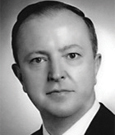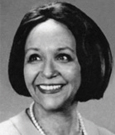On April 9, 1964, seven physicians—Jane Cooke Wright, MD, FASCO; Arnoldus Goudsmit, MD, PhD; Fred J. Ansfield, MD, FASCO; Harry F. Bisel, MD, FASCO; Herman H. Freckman, MD, FASCO; Robert W. Talley, MD, FASCO; and William Wilson, MD, FASCO—met for lunch at the Edgewater Beach Hotel in Chicago. They wanted to discuss the formation of a medical organization that focused on the clinical care of cancer and gave physicians treating patients with cancer a forum to share ideas and information.
At the time of that initial meeting—the first of four organizational meetings—there were not many physicians treating cancer. In fact, oncology was not yet a recognized discipline, and attending physicians were all general medicine doctors. Treatment for the disease centered on surgery and radiotherapy, and pessimism about making progress in cancer was high, but cure rates were low.1
Although the term “chemotherapy” had been coined more than half-a-century before by German chemist Paul Ehrlich to describe the use of chemicals to treat disease, the era of chemotherapy did not begin until 1942, when physicians at New Haven Hospital in Connecticut successfully used nitrogen mustard to treat a patient with advanced lymphosarcoma.
A decade later, Dr. Goudsmit used nitrogen mustard to treat a woman diagnosed with cancer at the Cleveland Clinic. Told by the institution’s physicians that there was no therapy available for her disease, she sought treatment from Dr. Goudsmit, an internist in Youngstown, Ohio. She lived for at least another 10 years.
Dr. Goudsmit, along with Dr. Ansfield, is largely credited with organizing the effort to establish the Society.2 It was his belief that the advent of drugs in the treatment of cancer called for a new breed of physicians who focused on chemotherapy. They would later become known as medical oncologists.
“If it hadn’t been for the drugs, there would have never been an organization as what we have now,” said Dr. Goudsmit. “It’s only when … anticancer drugs became available that there was an opportunity for the oncologists.”
ASCO’s Defining Goals
Initially called the American Association of Clinical Oncologists—Dr. Wright later suggested the new organization be called the American Society of Clinical Oncology—the founders held the fourth and final organizational meeting on November 5, 1964, at the Lakeshore Hotel in Chicago. They sent invitations to join ASCO to 134 physicians. The invitations included a copy of Dr. Goudsmit’s essay, “Some Considerations Relative to the Present Status of Clinical Oncology,” in which he outlined shifting attitudes about the diagnosis and treatment of cancer and “the trend toward a greater patient-related orientation,” necessitating the need for an organization such as ASCO.
Although some physicians declined the invitation to join the fledgling clinical oncology organization, claiming the formation of a new society was unnecessary, 90 physicians joined ASCO, and 51 charter members attended the November meeting. During the meeting, Dr. Goudsmit announced six ambitious goals he had developed for ASCO:
- Provide the form, meeting ground, and means for formal and informal communication and mutual education for and among clinically oriented individuals with special knowledge and training in the field of human neoplastic diseases.
- Provide physicians with proper professional educational background material and the opportunity to facilitate their own improved management of neoplastic diseases.
- Sponsor or cosponsor the publication of photographs, books, and/or articles on the subject of clinical oncology. The publication of a special journal … is particularly appropriate. (The Journal of Clinical Oncology was launched January 1, 1983.)
- Collaborate with other medical and research organizations, national and otherwise, with a view of enhancing professional education in the area of diagnosis and treatment of patients with neoplastic diseases.
- Initiate, coordinate, and cooperate in projects of investigation of human neoplastic disease.
- Provide a corporate framework for the pursuit of these and related activities.
ASCO’s Evolution
ASCO’s first scientific Annual Meeting was held the following year on April 9, 1965, in the Bellevue Stratford Hotel in Philadelphia. More than 70 members and invited guests attended the inaugural event, which featured three presentations on leukemia and multiple myeloma.
Today, ASCO has grown to become the world’s leading professional society of multidisciplinary medical professionals who treat people with cancer. Among ASCO’s 35,000 members, including those in the United States and internationally, are clinical oncologists from all oncology disciplines and subspecialties; physicians and other health-care professionals participating in approved oncology training programs; oncology nurses; and other practitioners with an interest in oncology. Each year, ASCO’s Annual Meeting, which is now held over the course of 5 days, attracts more than 25,000 oncology professionals and features the presentation of more than 4,000 scientific abstracts.
Meet the Founders
Fred J. Ansfield, MD, FASCO
Along with Dr. Goudsmit, Dr. Ansfield is considered the driving force behind the founding of ASCO. At the time of the formation of ASCO, Dr. Ansfield was Associate Professor of Surgery, Cancer Research Hospital at the University of Wisconsin in Madison. An early pioneer in the use of chemotherapy, Dr. Ansfield led early clinical studies of fluorouracil (5-FU) in patients with several types of advanced solid-tumor cancers. He later studied the effect of adding vincristine to cyclophosphamide, 5-FU, methotrexate, and prednisone in advanced breast cancer.
During the formation of ASCO, Dr. Ansfield was responsible for outlining a long-range plan for the institution of clinical oncology as a specialty in medicine, with a primary focus on the training of specialists in the field.
Dr. Ansfield served as ASCO’s third President, from 1966 to 1967.
Harry F. Bisel, MD, FASCO
Dr. Bisel was born on June 17, 1918, in Manor, Pennsylvania. He received his medical degree from the University of Pittsburgh in 1942 and did graduate work at the University of Pennsylvania and Harvard Medical School. Dr. Bisel was the first formally trained oncologist hired by the Mayo Clinic. He went on to found the Mayo Clinic Section of Medical Oncology and was chairman from 1963 to 1972. He retired from the Mayo Clinic in 1983.
Dr. Bisel was an early researcher in advanced breast cancer, investigating the efficacy in clinical trials of combinations of agents, including 5-FU, cyclophosphamide, and prednisone with or without vincristine, among others.
As a founding member of ASCO, Dr. Bisel was charged with outlining a long-range plan for the institution of clinical oncology as a specialty in medicine. He also conceptualized the idea that “one full day … be held annually for scientific meetings.”
Dr. Bisel was elected the first President of ASCO, serving from 1964 to 1965.
Herman A. Freckman, MD, FASCO
Dr. Freckman was Director of Cancer Chemotherapy at The Christ Hospital in Cincinnati and an early researcher in such chemotherapeutics as intra-aortic infusion of 5-FU and cyclophosphamide in the treatment of lung cancer; chlorambucil and prednisolone for disseminated breast carcinoma; and intra-aortic infusion of 5-FU, methotrexate, cyclophosphamide, vinblastine, and vincristine, alone or in combination for advanced colorectal cancer.
Dr. Freckman was responsible for organizing a membership committee and recruiting new members into ASCO.
Arnoldus Goudsmit, MD, PhD, FASCO
A native of Amsterdam, Dr. Goudsmit earned his medical degree in 1931 from the University of Amsterdam and moved to New York 2 years later to study at Cornell University Medical College, where he received his PhD degree in biochemistry. He later studied internal medicine at the Mayo Clinic in Rochester, Minnesota.
As an internist in Youngstown, Ohio, in the 1950s, Dr. Goudsmit was the first physician there to use nitrogen mustard to treat a woman with cancer. Dr. Goudsmit credited his experience as the first President of the Ohio chapter of the American Society of Internal Medicine with helping him to establish ASCO.
A pioneer in advancing the field of chemotherapy, Dr. Goudsmit published a report of studies of heparin and cyclophosphamide in the treatment of lung cancer while he was organizing the launch of ASCO, drafting its constitution and organizational bylaws, and arranging for the Society to be incorporated.
Dr. Goudsmit remained dedicated to advancing research in chemotherapy throughout his career, and as late as the 1980s, he was involved in an Eastern Cooperative Oncology Group study of combinations of chemotherapy agents for advanced gastric cancer.
Robert W. Talley, MD, FASCO
When Dr. Goudsmit was planning for the establishment of ASCO, he asked Dr. Talley to be responsible for the area of “clinical science,” including the development of a comprehensive list of contemporary drugs and their application in the treatment of cancer. The list compiled by Dr. Talley was used to develop scientific programming for the ASCO Annual Meeting and other Society-sponsored educational initiatives.
William Wilson, MD, FASCO
At the early organizational meetings in the establishment of ASCO, Dr. Wilson was tasked with proposing a budget that would address the creation of a Society journal and other educational initiatives, including the Annual Meeting.
Jane Cook Wright, MD, FASCO
The only woman and the only African American among the original ASCO founders, Dr. Wright served as the Secretary-Treasurer during the formation and early years after ASCO’s establishment. Dr. Wright was the last surviving member of the original seven founders, and she died on February 19, 2013, at the age of 93. In recognition of Dr. Wright’s contribution to cancer research, ASCO and the Conquer Cancer Foundation created the Jane C. Wright, MD, Young Investigator Award in 2011. ■
References
1. DeVita VT, Chu E: A history of cancer chemotherapy. Cancer Res 68:8643-8653, 2008.
2. Krueger GM, Alexander LI, Whippen DA, et al: Arnoldus Goudsmit, MD, PhD: Chemotherapist, visionary founder of the American Society of Clinical Oncology, 1909-2005. J Clin Oncol 24:4033-4036, 2006.








